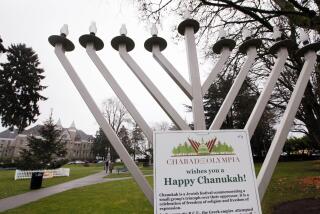Exhibit Focuses on Midwestern Jews
- Share via
DES MOINES — It seems Jewish mothers are the same whether they live in New York or North Dakota.
North Dakota?
“Jewish history didn’t just happen in New York City,” says Linda Mack Schloff, one of the curators of an exhibition chronicling the history of Jewish women on the prairie.
“The whole idea about Jewish women homesteading on the prairie is rather unique,” said Schloff, who directs the Jewish Historical Society of the Upper Midwest in St. Paul, Minn. “There are Jews sprinkled all over the state. I think that really surprises people.”
Even in Fargo, N.D., grandmas want their girls to find nice Jewish boys.
“My grandmother used to cook for Jewish peddlers who stopped in Fargo. She got three Jewish sons-in-law that way,” a voice-over says with obvious pride. The video welcomes visitors at the entrance to “Unpacking the Prairie: Jewish Women in the Upper Midwest.”
The exhibit, assembled by the St. Paul-based Minnesota Historical Society, is on a five-year tour through several Midwest states. Heirlooms from Jewish families in Iowa complement the exhibition in Des Moines.
Between 1881 and 1924, more than 2 million Jews, mostly from the Russian Empire, left for the United States. By the 1930s, about 50,000 were living in the Midwest.
Many were attracted by the prospect of farming, which was banned for Jews in Russia. Others wanted to escape overcrowded cities on the East Coast.
“In a place where Jews were so spread out and didn’t always have the most common institutions of synagogues and rabbis, the family was more important,” Schloff said, “and the women had a more critical role to play in maintaining any forms of religious expression.”
And what women carried with them--white Sabbath tablecloths or family recipes--allowed them to pass along traditions in a place that one woman in the video characterized as “the end of the world.”
Visitors to the exhibit learn how to prepare gefilte fish, a traditional Passover dish, from a Lake Superior catch. “Any fine cook uses kosher salt,” Etheldoris Stein Grais of Hibbing, Minn., confides in one- to two-minute tips on a video.
Children can touch a cloth sack full of items that Jews brought to the prairie, including Sabbath candlesticks, sewing thimbles and soup ladles. In Des Moines, the exhibit includes a cup made by a woman rescued from Auschwitz by the owner of the factory where she worked: Oskar Schindler.
“Even though we have a decent-sized community, a lot of people don’t know what Jews are,” said Janice Rosenberg, director of the Iowa Jewish Historical Society.
“Some people from small towns have never met a Jewish person,” she said. “Jewish culture is beautiful and special, and we want to show that it’s so beautiful that people brought it with them to America.”
The exhibition is scheduled to travel to St. Cloud, Duluth, Albert Lea, Hinkley and Chisholm, Minn.; Pierre, Aberdeen and Sioux Falls, S.D.; Bismarck, N.D.; West Bloomfield, Mich.; Washington; and Calgary, Alberta. It is at the Iowa State Historical Society in Des Moines through July 26.
More to Read
Sign up for The Wild
We’ll help you find the best places to hike, bike and run, as well as the perfect silent spots for meditation and yoga.
You may occasionally receive promotional content from the Los Angeles Times.






